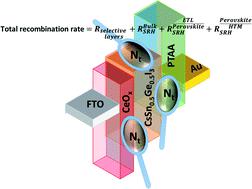当前位置:
X-MOL 学术
›
Sustain. Energy Fuels
›
论文详情
Our official English website, www.x-mol.net, welcomes your
feedback! (Note: you will need to create a separate account there.)
Harnessing the potential of lead-free Sn–Ge based perovskite solar cells by unlocking the recombination channels
Sustainable Energy & Fuels ( IF 5.0 ) Pub Date : 2021-07-26 , DOI: 10.1039/d1se00687h Yassine Raoui, Samrana Kazim, Yulia Galagan, Hamid Ez-Zahraouy, Shahzada Ahmad
Sustainable Energy & Fuels ( IF 5.0 ) Pub Date : 2021-07-26 , DOI: 10.1039/d1se00687h Yassine Raoui, Samrana Kazim, Yulia Galagan, Hamid Ez-Zahraouy, Shahzada Ahmad

|
Perovskite solar cells (PSCs) have celebrated a decade of investigation as a promising photovoltaic technology. However, they contain lead, so inorganic lead-free PSCs can be designed as green and clean energy sources. To overcome the current obstacles in lead-free PSCs, the stability and performance gap should be minimized. The drift-diffusion simulation model is a conducive way to understand the working mechanism in a thin-film solar cell. Here we adopted a computational approach to design and investigate the performance of CsSn0.5Ge0.5I3 as a light harvester. We optimize the thickness of the perovskite, for its use in an inverted planar structure (FTO/PCBM/CsSn0.5Ge0.5I3/Spiro-OMeTAD/Au). Furthermore, cerium oxide (CeOx) and PTAA are used as alternative electron and hole transport layers, respectively. We studied the effect of trap density in the bulk CsSn0.5Ge0.5I3 and its impact on performance, recombination rate, and diffusion length. The open-circuit voltage (Voc) showed a significant improvement and the correlation with the trap density at the interface layers is established. We noted that the defect density at the perovskite/hole selective layer interface has a profound impact on the performance of lead-free PSCs as compared to the electron selective layer/perovskite interface. After optimizing defect parameters, the lead-free PSC can deliver a PCE of 24.20%, with Voc = 1170 mV, Jsc = 25.80 mA cm−2, and FF = 80.33%. Our findings provide access guidelines and pave the way for lead-free PSCs based on the Sn–Ge combination to approach their limit.
中文翻译:

通过解锁复合通道来利用无铅 Sn-Ge 基钙钛矿太阳能电池的潜力
钙钛矿太阳能电池 (PSC) 作为一种很有前途的光伏技术,已经庆祝了十年的研究。然而,它们含有铅,因此无机无铅 PSC 可以设计为绿色清洁能源。为了克服目前无铅 PSC 的障碍,稳定性和性能差距应该最小化。漂移扩散模拟模型是了解薄膜太阳能电池工作机制的有益方法。在这里,我们采用计算方法来设计和研究 CsSn 0.5 Ge 0.5 I 3作为光收集器的性能。我们优化了钙钛矿的厚度,将其用于倒置平面结构 (FTO/PCBM/CsSn 0.5 Ge 0.5 I 3/Spiro-OMeTAD/Au)。此外,氧化铈 (CeO x ) 和 PTAA 分别用作替代电子和空穴传输层。我们研究了 CsSn 0.5 Ge 0.5 I 3体中陷阱密度的影响及其对性能、复合率和扩散长度的影响。开路电压 ( V oc) 显示出显着改善,并建立了与界面层陷阱密度的相关性。我们注意到,与电子选择层/钙钛矿界面相比,钙钛矿/空穴选择层界面的缺陷密度对无铅 PSC 的性能有深远的影响。优化缺陷参数后,无铅 PSC 可提供 24.20% 的 PCE,V oc = 1170 mV,J sc = 25.80 mA cm -2,FF = 80.33%。我们的研究结果提供了获取指南,并为基于 Sn-Ge 组合的无铅 PSC 接近其极限铺平了道路。
更新日期:2021-08-13
中文翻译:

通过解锁复合通道来利用无铅 Sn-Ge 基钙钛矿太阳能电池的潜力
钙钛矿太阳能电池 (PSC) 作为一种很有前途的光伏技术,已经庆祝了十年的研究。然而,它们含有铅,因此无机无铅 PSC 可以设计为绿色清洁能源。为了克服目前无铅 PSC 的障碍,稳定性和性能差距应该最小化。漂移扩散模拟模型是了解薄膜太阳能电池工作机制的有益方法。在这里,我们采用计算方法来设计和研究 CsSn 0.5 Ge 0.5 I 3作为光收集器的性能。我们优化了钙钛矿的厚度,将其用于倒置平面结构 (FTO/PCBM/CsSn 0.5 Ge 0.5 I 3/Spiro-OMeTAD/Au)。此外,氧化铈 (CeO x ) 和 PTAA 分别用作替代电子和空穴传输层。我们研究了 CsSn 0.5 Ge 0.5 I 3体中陷阱密度的影响及其对性能、复合率和扩散长度的影响。开路电压 ( V oc) 显示出显着改善,并建立了与界面层陷阱密度的相关性。我们注意到,与电子选择层/钙钛矿界面相比,钙钛矿/空穴选择层界面的缺陷密度对无铅 PSC 的性能有深远的影响。优化缺陷参数后,无铅 PSC 可提供 24.20% 的 PCE,V oc = 1170 mV,J sc = 25.80 mA cm -2,FF = 80.33%。我们的研究结果提供了获取指南,并为基于 Sn-Ge 组合的无铅 PSC 接近其极限铺平了道路。











































 京公网安备 11010802027423号
京公网安备 11010802027423号